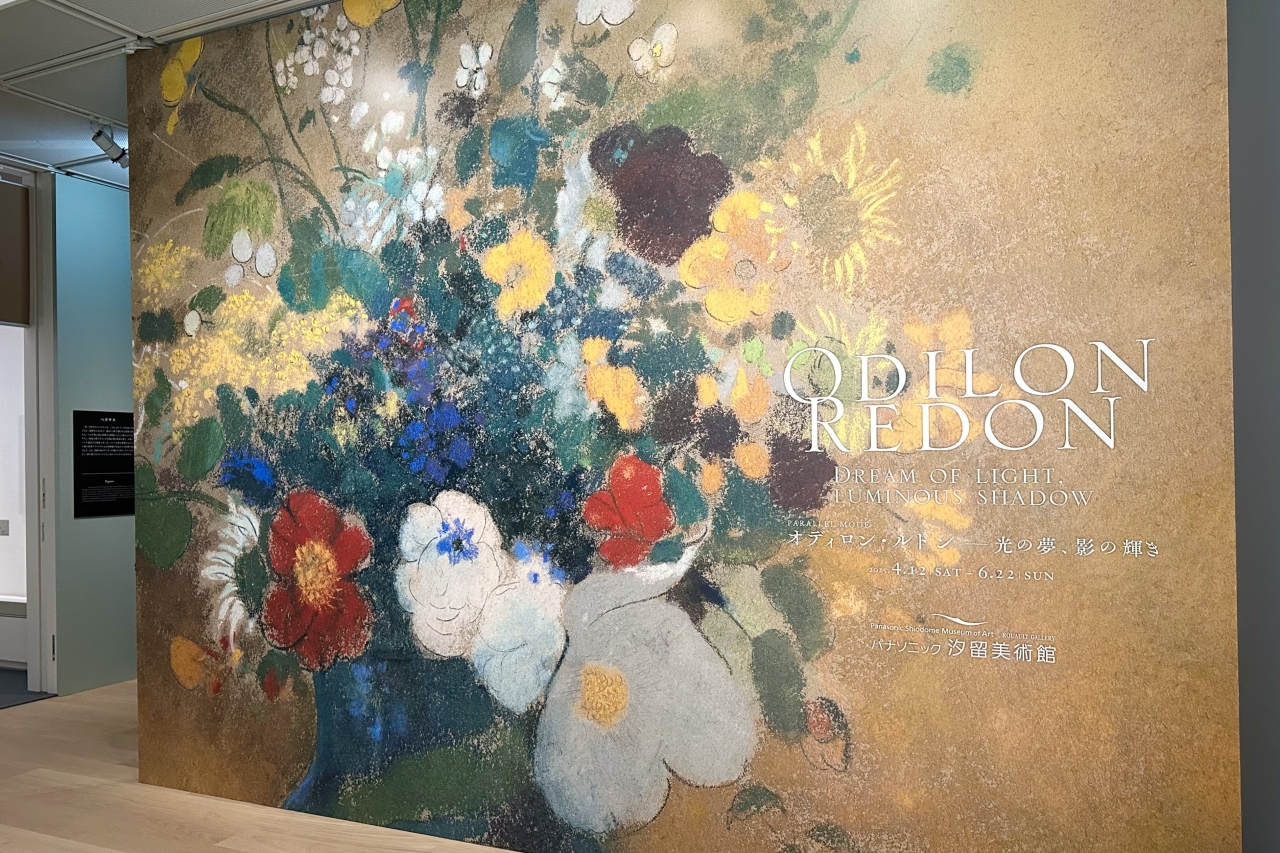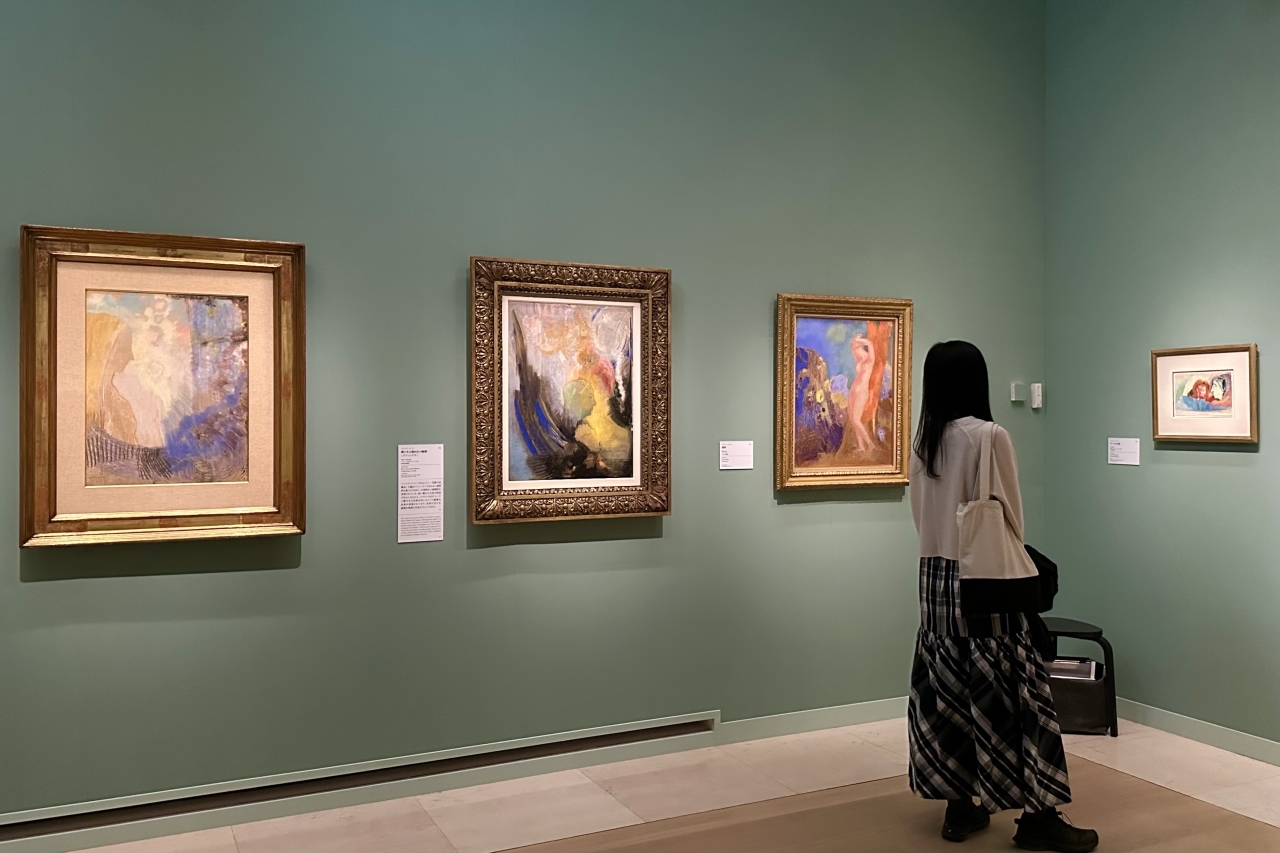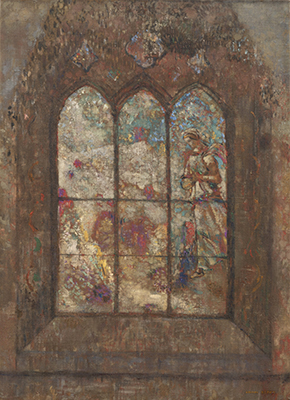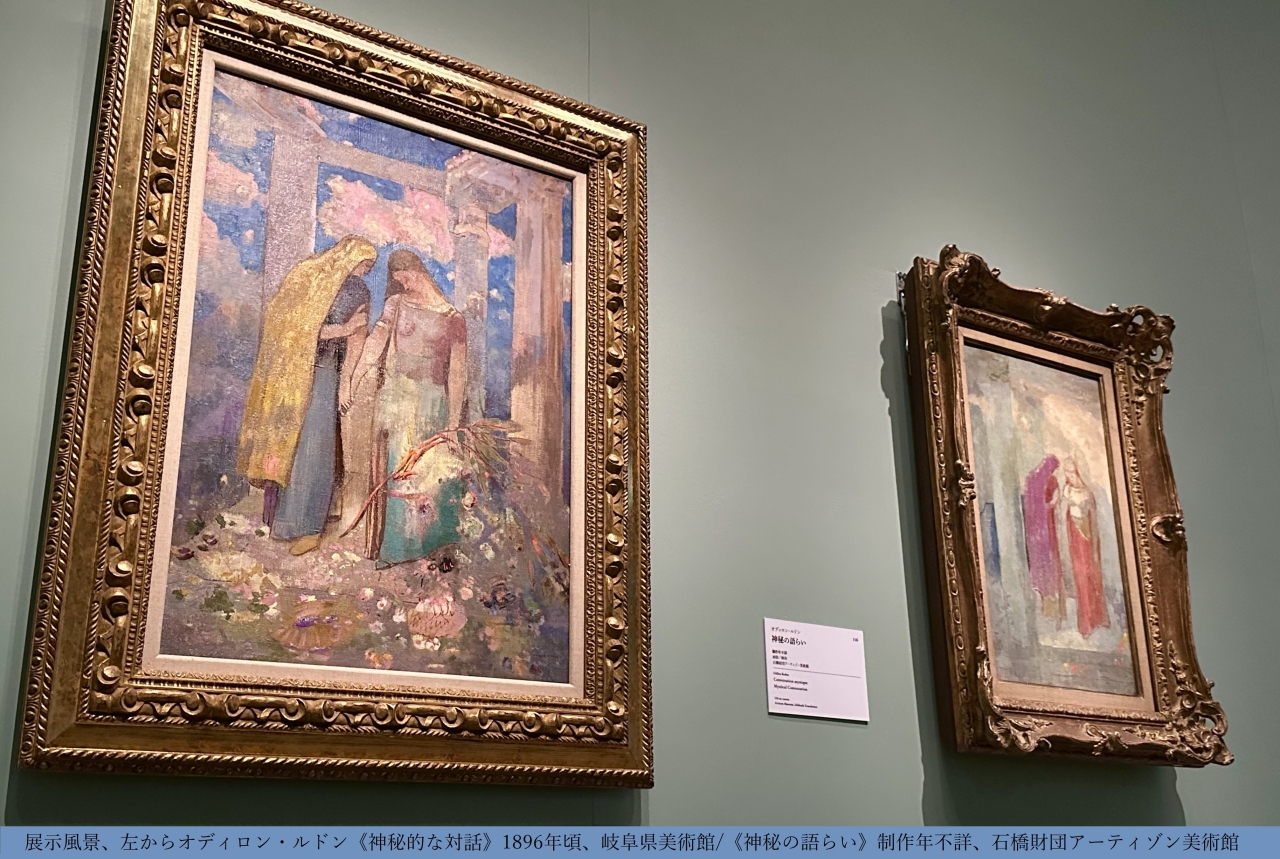
Odilon Redon (1840-1916) was born in the same generation as Monet and other Impressionist painters, who vividly captured everyday scenes in the shifting light of the day. However, he was known as one of the leading French Symbolist painters, painting fantastical worlds dominated by deep darkness and filled with visions that could be described as bizarre and mysterious.
The Panasonic Shiodome Museum of Art has opened an exhibition entitled "PARALLEL MODE: Odilon Redon – Dream of Light, Radiance of Shadow," showcasing the full scope of his rich artistic career through approximately 110 works, including masterpieces from Japan and abroad, centered on works from the Gifu Prefectural Museum of Art, which boasts one of the world's leading Redon collections . The exhibition will run from Saturday, April 12, 2025 to Sunday, June 22, 2025.
The exhibition begins with "Prologue: Japan and Redon," which introduces the history of Redon's reception in Japan, and is divided into three chapters that provide a chronological overview of his artistic career: "Chapter 1: The birth and development of the artist 1840-1884," "Chapter 2: The approaching fin de siècle: The expansion of exhibition venues, partings and encounters 1885-1895," and "Chapter 3: Modernist/Contemporarian Redon: The dawn of a new era 1896-1916."
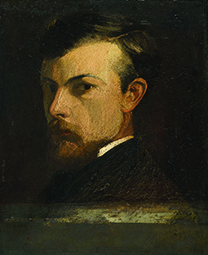
Odilon Redon, Self-Portrait, 1867, oil on panel, 41.7 x 32 cm, Musée d'Orsay © GrandPalaisRmn (musée d'Orsay) /Hervé Lewandowski / distributed by AMF
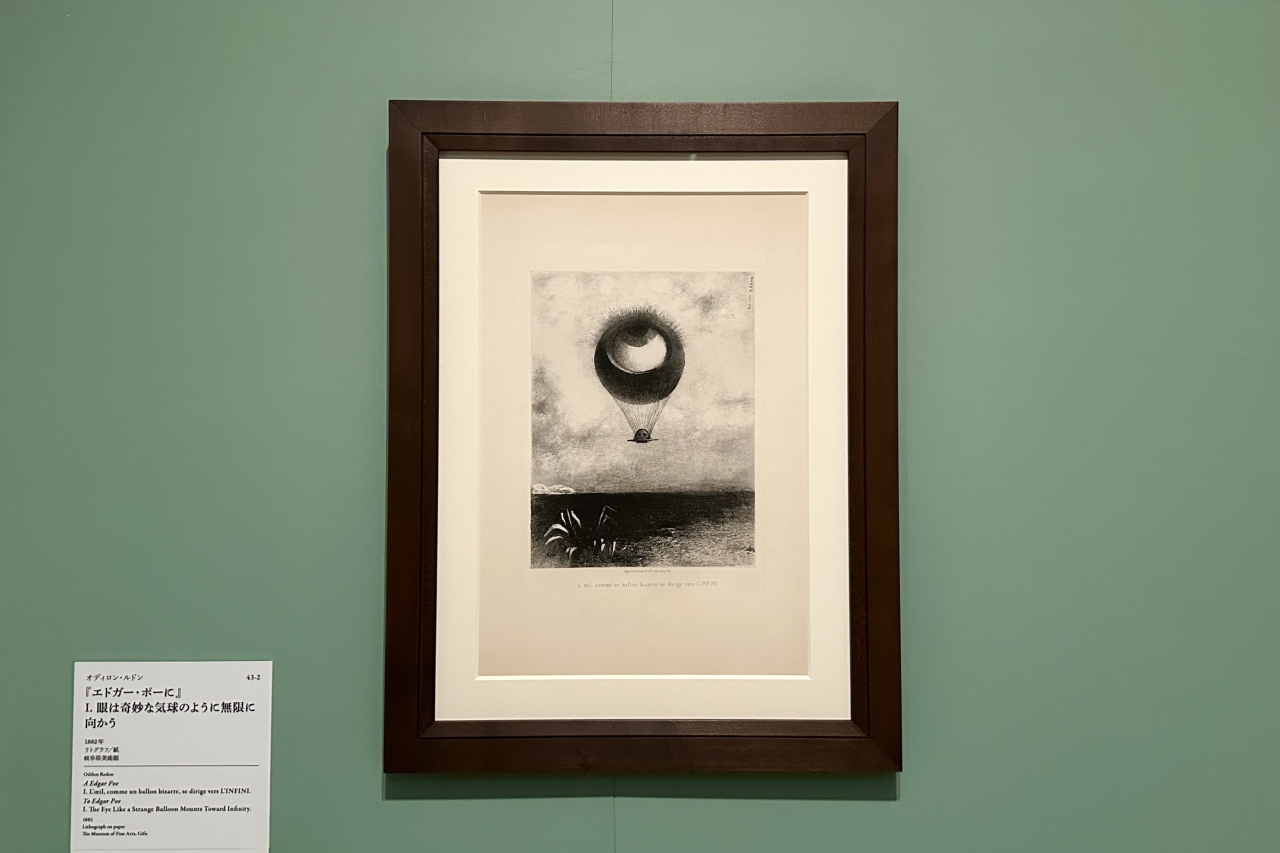
Installation view, Odilon Redon, "To Edgar Poe" I. The Eyes, Like Strange Balloons, Head to Infinity, 1882, Gifu Prefectural Museum of Art
When you think of Redon, many people may immediately think of his eerie monochrome paintings of balloons with eyes, spiders with human faces, etc. Chapter 1 introduces how Redon came to create such a unique worldview.
Born in Bordeaux, a port city in southwestern France, Redon was sickly, so shortly after his birth he was left in the care of an elderly couple who lived in Peyre-Loubert, a desolate estate with many vineyards on the outskirts of Bordeaux. His solitary childhood, spent in a sparsely populated environment surrounded by nature, nurtured his inner sensibility and imagination.
As he grew up, Redon studied drawing and copying under the watercolorist Stanislas Gorin in Bordeaux, after which he decided to seriously pursue a career as a painter. In 1864, he went to Paris to study art under Jean-Léon Gérôme, a representative of Academic art, but was unable to adapt, and after returning home he studied copperplate engraving under the wandering printmaker Rodolphe Bresdin .
Bresdin, skilled at blending realism with the imagination and well versed in the interplay of light and shadow, black and white, had a major influence on Redon's early career as an artist. Bresdin's fantastical style, which meticulously depicts mysterious creatures, holy families, and epic battles in romantic landscapes of lush forests and swamps, is also connected to Redon's biographical themes.
On the other hand, the botanist Armand Claveau , whom Redon met in his youth, was also one of the key figures who determined Redon's direction as a painter. Redon was fascinated by Claveau's microscopic world, where he observed cells and tissues invisible to the naked eye under a microscope and was engrossed in "studying the tiny traits that connect the lives of plants and animals." Through their friendship, Redon deepened his knowledge of not only natural sciences but also literature and philosophy, forming the ideas that would become the foundation of his later artistic expression.
After these experiences, Redon moved back to Paris in 1872 and used black, which he recognized as "the most essential color" and "a worker for the spirit," to express fantastical images of bizarre creatures roaming the streets, and his interest in the latest technology such as hot air balloons and light bulbs, in a style different from that of his contemporaries the Academicists and Impressionists. He called these works "black (noir)."

Odilon Redon, "The Quest for the Absolute… Philosopher", 1880, charcoal on paper, 43.2 x 35.2 cm, Gifu Prefectural Museum of Art
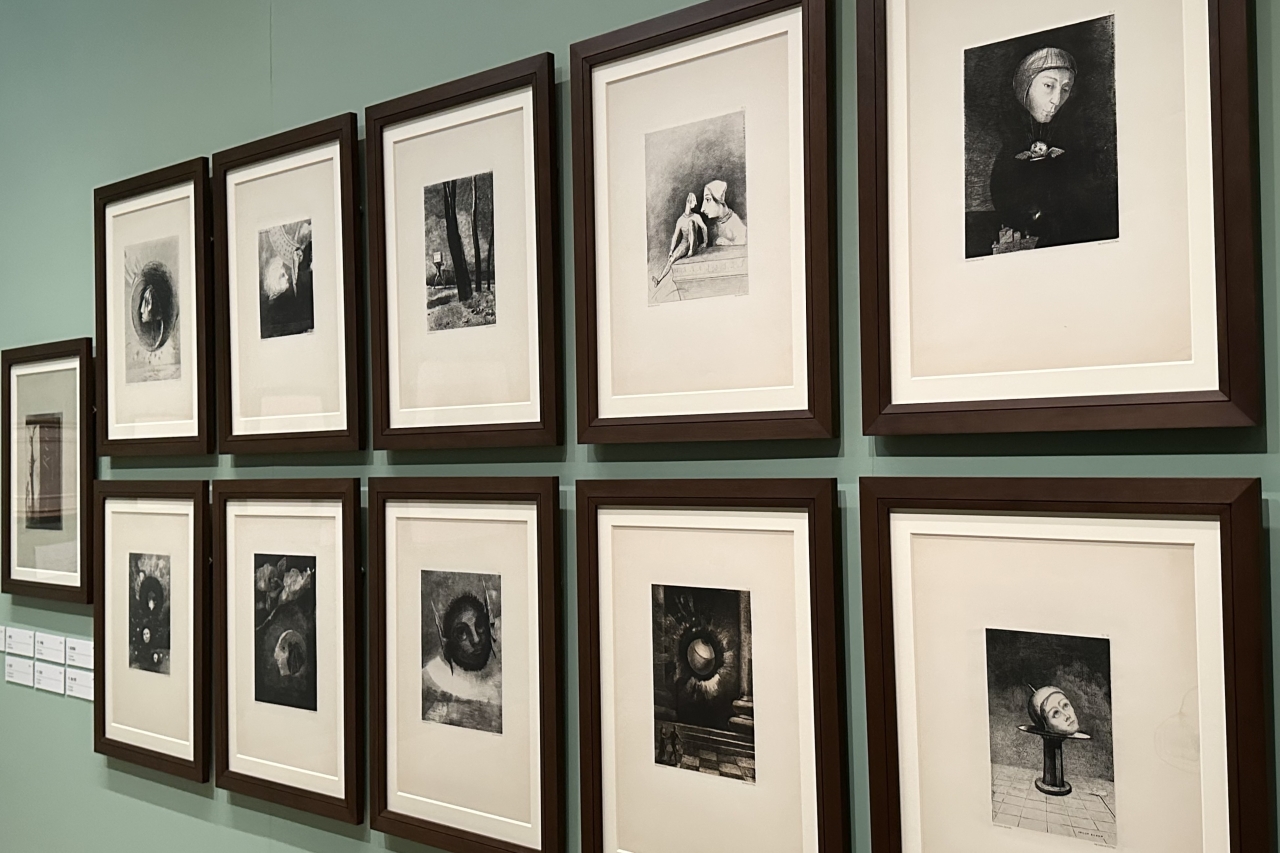
Exhibition view, 11 lithographs including the cover of Odilon Redon's "In a Dream", 1879, Gifu Prefectural Museum of Art
The exhibition will feature a wide range of works, from landscape paintings of his hometown to charcoal drawings and early lithographs. You can see all of the lithographs included in his first lithograph collection , "In a Dream" (1879), and his third, "Origin" (1883).
"The Origin" is thought to have been inspired by Darwin's "Theory of Evolution," who died the previous year, and is a collection of exceptionally high-quality works that could be described as Redon's imaginary theory of evolution. Among them, the influence of Claveau is particularly evident in the opening scenes, "The Origin I. When life awakened in the depths of vague matter" and "The Origin II. Perhaps the first attempt at vision in a flower," which depict creatures in an undifferentiated state between animals and plants.
Images of plants with human eyes and heads appear frequently in Redon's works, and it is said that they were inspired by an illustration in Claveau's book showing the germination of beans.
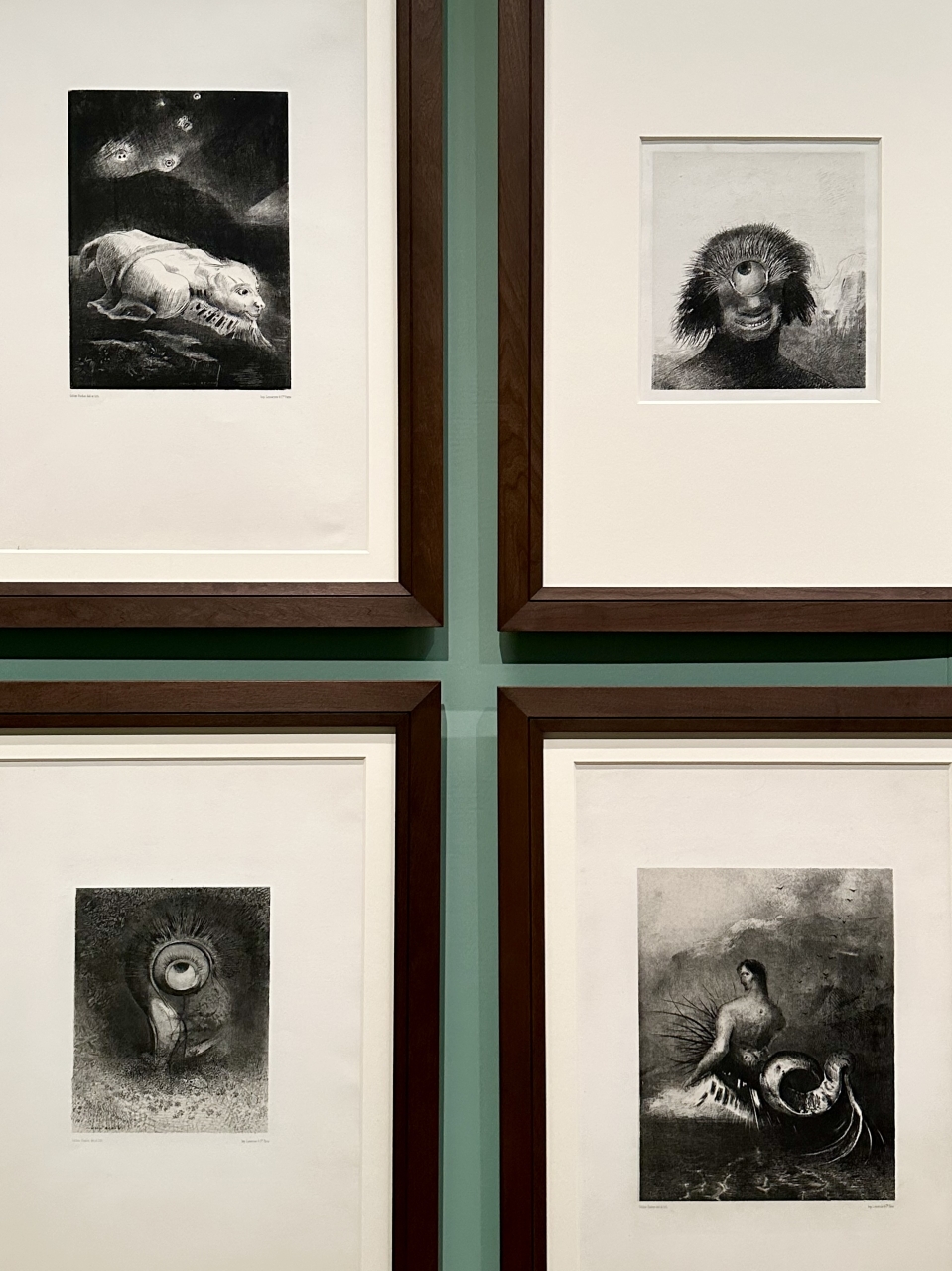
Exhibition view, upper left: Odilon Redon's "Origin I. When life awakened in the depths of vague matter", lower left: "Origin II. Perhaps the first attempt at vision in a flower", upper right: "Origin III. The misshapen polyp drifted along the shore like an ugly one-eyed giant with a grin", lower right: "Origin IV. The siren emerged from the waves with countless needles", 1883, Gifu Prefectural Museum of Art
The creatures depicted by Redon are entirely imaginary, and although they range in appearance from surreal to comical, they all share a strangely vivid quality.
While studying in Paris, Redon met the master of landscape painting, Camille Corot, who advised him, "By placing objects directly based on nature next to fantastical images, the world of imagination becomes more realistic." Redon followed this advice and devoted himself to naturalistic landscape painting, and from this experience he was able to paint fantastical creatures with a visible logic based on the real laws of nature, a realistic technique, so to speak, which allowed him to succeed in bringing them to life, which is what makes Redon's work so unique.
The venue is a museum run by Panasonic, and the lighting is exquisite, with particular attention paid to highlighting the nuances and gradations of black. You can fully enjoy the charm of the black of Redon, who is also known as the "painter of black."
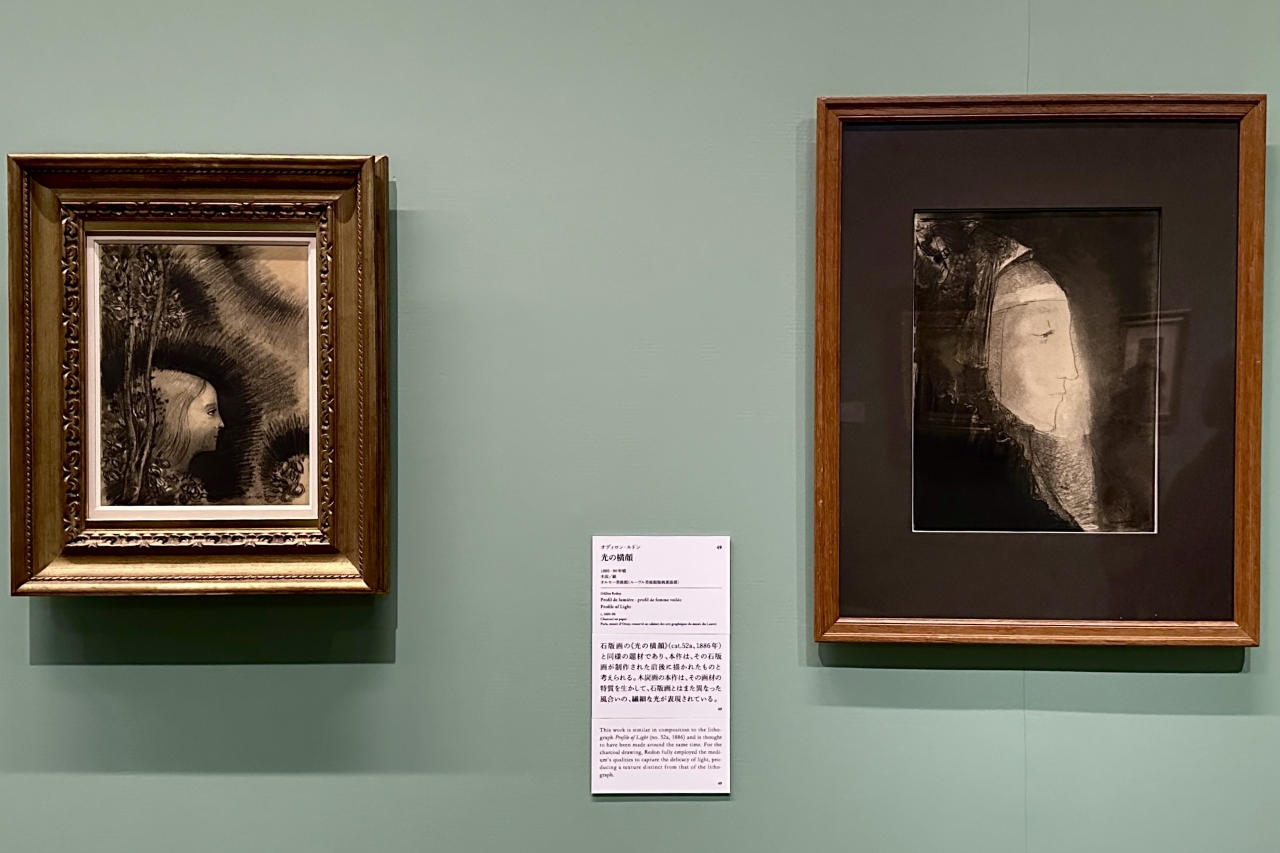
Exhibition view, from left: Odilon Redon "Profile of a Woman" circa 1885, Gifu Prefectural Museum of Art / "Profile of Light" circa 1885-90, Musee d'Orsay (Louvre Museum Prints and Drawings Department)
In the 1880s, Redon's Black series of works attracted widespread attention when the writer Joris-Karl Huysmans introduced them as symbols of fin de siècle decadence, and in the 1890s, young artists, particularly the Nabis, came to admire him as a pioneer of new art.
Redon was well on his way to establishing himself as a painter, but around 1890, at the age of 50, his style suddenly changed dramatically. He began to choose mysterious worlds of light as the subject of his works, rather than the world of darkness, and his black color changed from one that represented a darkness that absorbed light to one that represented light itself.
The background to this is said to be the birth of Redon's second son, Ali. In 1886, the elderly Redon was blessed with a long-awaited son, Jean, but he died just six months later. Redon was deeply disappointed, but three years later, in 1889, his second son Ali was born, and it is said that this link between Redon's state of mind at the height of his happiness and his style of painting.
Furthermore, in a letter written in 1895 after he had fallen seriously ill, Redon stated, "It is true that I am gradually moving away from black. Between you and me, black exhausts me greatly," and in a letter written in 1902, he went so far as to declare, "I have married color. I can no longer do without it." The successive psychological blows he suffered, namely the death of his mentor Claveau and the sale of Peilerbad, his creative source, may have had some bearing on his change of heart.
In any case, from the 1890s onwards, Redon began to use a wealth of colours, primarily in oil and pastel paintings. At the exhibition, you can experience the dramatic sensation of suddenly going from a gloomy world of black into a world of light bursting with colour.
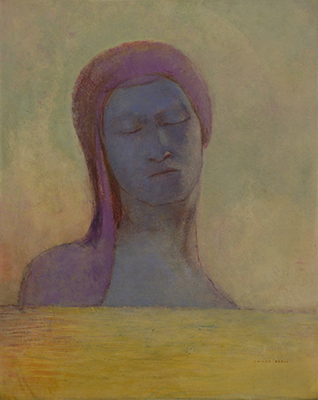
Odilon Redon, "Closed Eyes," circa 1890, oil on paper, 44.5 x 36.5 cm, private collection (with the cooperation of Fujikawa Gallery)
Redon's Closed Eyes (c.1890), believed to have been created the year after his second son Ali was born, is the earliest example of the imaginative world he had developed in his Black series expressed in color. It depicts a gigantic bust of a woman with her eyes closed, facing the horizon or beyond it, and he produced many variations on this theme during the same period.
Many of the "Black" works emphasize the motif of the "eye," which can be interpreted in multiple ways, such as Redon's gaze exploring an invisible world of illusion, the gaze of an immanent other, or a symbol of the soul or intellect. However, this work, which marks a transition from monochrome to rich color, is highly suggestive in that the subject, as if liberated from such "eyes," simply surrenders to the world and wears an expression of ecstasy in a state of fulfilled peace.
Redon moved to Paris in 1896 and began working there, embarking on the decorative painting style that the Nabis painters had embarked on. While he continued to work on mystical subjects, he also worked on easily recognizable subjects such as mythology, religion and people. In particular, "Flowers in a Vase" was an ideal subject for Redon, who explored color, and became a representative subject of his later years.

Exhibition view, from left: Odilon Redon, "Vase of Flowers," circa 1908-10, private collection (with cooperation from Fujikawa Gallery); "Flowers," circa 1905-10, Gifu Prefectural Museum of Art; "Japanese-style Vase," 1908, Pola Museum of Art
Among the colorful chapter 3, the section featuring seven "Flowers in a Vase" is particularly gorgeous. You can see Redon's evolution as he pursued the light effects created by the overlapping of different types of pastel and a painting style that gives off a pastel-like glow despite being made with oil paints.
One of the characteristics of Redon's "Flowers in a Vase" is that the location of the vase is left ambiguous in the work. The unique and unique mystical atmosphere created by the mixture of real flowers and imaginary flowers that welled up from within Redon has fascinated many art lovers.
This chapter also introduces Redon's Window (c.1906), a painting of stained glass, one of the major subjects of his later years, which will be on public display in Tokyo for the first time.
The exhibition "Odilon Redon – Dream of Light, Splendor of Shadow" allows visitors to experience the charm of Redon's art, which moved from darkness to light, valued reality and fantasy as equal, and created a unique world. It will be held until Sunday, June 22, 2025.
■ Overview of "Odilon Redon – Dream of Light, Brilliance of Shadow"
| Dates | April 12, 2025 (Sat) – June 22, 2025 (Sun) |
| venue | Panasonic Shiodome Museum of Art (4F Panasonic Tokyo Shiodome Building, 1-5-1 Higashi-Shinbashi, Minato-ku, Tokyo) |
| Opening hours | 10:00-18:00 (last entry at 5:30pm)
* Open until 8pm on Friday, May 2nd, Friday, June 6th, Friday, June 20th, and Saturday, June 21st (entry until 7:30pm) |
| Closed Days | Wednesdays (except June 18th) |
| Admission Fee | Adults: 1,300 yen, 65 years and older: 1,200 yen, university and high school students: 800 yen, junior high school students and younger: free
* Free for those who present a disability certificate and up to one accompanying person * Please make a reservation for a specific date and time on Saturdays, Sundays, and public holidays (no reservation required on weekdays). |
| Organizer | Panasonic Shiodome Museum of Art |
| Museum official website | https://panasonic.co.jp/ew/museum/ |
*The contents of this article are from the time of the press preview. It may differ from the latest information, so please check the official website for details.
<Past interview articles>
[Report] Matsuya Ginza and beef bowl restaurant "Matsuya" collaborate for the first time! Premium products using Kobe beef will be available at "Matsuya's Meat Activity in GINZA"
